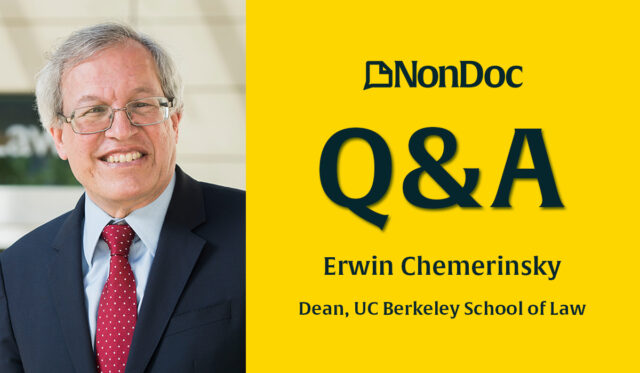

Renowned constitutional scholar Erwin Chemerinsky recently visited the University of Tulsa College of Law to participate in a lecture about free speech and academic freedoms on college campuses.
Chemerinsky, 70, was born in Chicago and graduated Harvard Law School. He worked for the federal government and in private practice, eventually teaching at the Gould School of Law at the University of Southern California from 1983 through 2004. After years at the Duke University School of Law, Chemerinsky joined the University of California higher education system, becoming dean of the Berkeley School of Law in 2017.
During his Feb. 1 talk in Tulsa, Chemerinsky emphasized four key points:
- All ideas and views can be expressed on a college campus;
- Free speech is not absolute;
- Colleges and universities can have time, place and manner restrictions; and
- These principals can be used to analyze and understand contemporary free speech controversies on college campuses, such as diversity, equity and inclusion offices, speech about the Israel-Hamas War, and social media use by students.
“Free speech is ultimately based on a faith — a faith that we are all better off when all ideas and views can be expressed,” Chemerinsky said near the conclusion of his talk. “I have that faith, at least most of the time.”
Prior to his lecture, Chemerinsky spoke with NonDoc about his thoughts on federal Indian law issues that have become prominent in Oklahoma since the U.S. Supreme Court’s McGirt v. Oklahoma decision.
The following conversation has been edited lightly for clarity, length and style.
What is the normal constitutional relationship between state governments and the federal government?
The relationship of the federal government to the state governments is complicated, and it’s been contested over the course of American history. The basics of it is the federal government has limited authority and can act only where the Constitution specifically provides power, whereas state governments can do anything except what the Constitution provides for and prohibits them from doing. But this is overly simplistic. Over the course of American history, the powers of the national government have tremendously increased. It’s necessary as the economy and society become more complicated.
There are often conflicts between the federal government and the states in terms of authority. I think it’s important to recognize that some of the most important issues in American history have been fought over the terms of the relationship between the federal government and the states. In the early 19th century, the opposition to the abolition of slavery was phrased as states’ rights. From the 1890s to the 1930s, the Supreme Court struck down over 200 federal, state and local laws. The Supreme Court in the 1990s struck down many federal laws based on infringing state sovereignty, and today there continue to be disputes between the federal government and the states, especially now over immigration.
What does the Constitution say about Native Americans and tribes?
The Constitution says remarkably little about Indians and Indian tribes. Perhaps the most important provision is in Article 1, Section 8 that gives Congress the power to regulate commerce with Indian tribes. It’s long been said that the federal government has plenary power in this way and that the relationship between the federal government and Indian tribes is a relationship between one sovereign and another. But we know the tragic history of Native Americans in this country. We know of the Trail of Tears. We know of the failure of the government to adequately protect the rights of Native Americans.
Where do tribal governments fit between state governments and the federal government in the United States’ constitutional order?
It’s a complicated relationship. There are areas where tribes have sovereignty, there are areas where tribes have limited sovereignty, and there are areas where tribes have no sovereignty. The Supreme Court handed down a decision just a few years ago, McGirt v. Oklahoma, which in a 5 to 4 decision said that, in a large area of Oklahoma, Native Americans could not be prosecuted in state court for crimes that were committed on Native American reservations — that they’d have to be prosecuted in either federal court or in tribal court. But just a short time after that, in another case, Castro-Huerta v. Oklahoma, the Supreme Court said if a non-tribal member commits a crime on tribal land, even if the crime is against a tribal member, that can be prosecuted in state court. The difference, I think, was Justice (Ruth Bader) Ginsburg was part of a 5-4 majority in the first case, and then she was replaced by Justice (Amy Coney) Barrett, who joined the dissenters in McGirt to create a new majority. But I think this reflects the complex relationship between the national government, the tribes and the states.
A lot of attorneys I’ve talked with tell me they think McGirt and Castro-Huerta are incompatible rulings, that the Supreme Court has opened up more issues than it has resolved. How does the Supreme Court usually react to controversial cases like this? Should we expect a lot of cases going to the Supreme Court to clarify the law, or are they more likely to change course and try and settle this in a few big cases?
It’s hard to know at this point in time. I think McGirt was right, and my optimistic self thinks that by limiting it in Castro-Huerta, maybe the dissenters from McGirt — now the majority in Castro-Huerta — might be less likely to overrule McGirt in the future. My pessimistic self suggests that there is a tension between McGirt and Castro-Huerta, McGirt would not be decided the same way today, and that the majority in Castro-Huerta may be poised to overrule McGirt. That’s why I say it’s impossible to know.
There have been a few Indian law scholars that have proposed reimagining American federalism, with tribal governments worked into our understanding. Do you think these discussions about how tribal sovereignty fits into federalism are on the right track?
I’ve read that scholarship; I think it’s quite persuasive. I think it would be a useful way to go forward in imaging the relationship between the federal government and Indian tribes. On the other hand, I don’t think it’s likely in the foreseeable future. I think it would be a dramatic change, and maybe the McGirt majority might have been willing to point in that direction. I think the more recent Castro-Huerta majority makes it less likely that a majority of the court wants to see that. But one thing I should say in that regard: In Justice Neil Gorsuch, Native American tribes have one of the best advocates on the U.S. Supreme Court that has ever been there. And if there is any justice who would be receptive to this theory, it would be Justice Gorsuch, and maybe in time he’ll persuade his colleagues.
Is there anything else you’d like to share with our readers?
Sure. Last year, the Supreme Court had a major decision with regards to Native Americans — the Haaland vs. Brackeen case — about the Indian Child Welfare Act. And it’s notable that the Supreme Court upheld the Indian Child Welfare Act but left open a key question. There is a long tragic history in the United States of governments, including the federal government, removing Native American children from the Native American community. The Indian Child Welfare Act, adopted in 1978, said that if a Native American child is being placed in foster care or put up for adoption, preference should be given for a Native American family.
A challenge was brought, the federal district court declared it unconstitutional, and the 5th Circuit affirmed it. The district court said that Congress lacked the power to adopt it. The 5th Circuit and the Supreme Court both said Congress did have the power to adopt the law. That’s important because, if Congress didn’t have the power to adopt this, many laws adopted in terms of Native Americans would have been declared unconstitutional. The district court and the 5th Circuit agreed and said that this violated the 10th Amendment because it was compelling state courts to implement a federal mandate, and the Supreme Court unanimously rejected that argument and said Congress can force state courts to administer federal law. But there was one other issue, and that’s whether the preference for Native American families in foster care and adoption was an impermissible racial preference. The 5th Circuit split on this, and the Supreme Court dismissed the issue for lack of standing, but it is enormously important in terms of the future of the Indian Child Welfare Act.
More generally, my law school gives a full scholarship to every Native American who is an enrolled tribal member. The University of California gives scholarships to those who are enrolled members of Native American tribes. If this is deemed a racial preference, it won’t be permissible. If it is a political preference, a preference based on political affiliation, then it’s allowed. And that’s the issue the Supreme Court didn’t decide.
What does it mean that being Native American is a “political classification” instead of a racial one?
The issue is: “Is being Native American, an enrolled tribal member, a racial characteristic or is it a political affiliation?” If it is a racial characteristic, then the Supreme Court is going to declare, in all likelihood, that its unconstitutional, any preference based on it. The Supreme Court has made clear that it’s not going to permit racial preferences, such as in admissions to schools and scholarships.
On the other hand, one can say that being an enrolled tribal member is a political affiliation. The tribes are sovereigns, so then the preference — placing children in foster care or adoptions or scholarships — would be allowed. Justice Barrett’s opinion in Haaland v. Brackeen didn’t address it. However, Justice (Brett) Kavanaugh in a concurring opinion said he thought it was a racial classification. I think Justice Gorsuch as well as Justices (Sonia) Sotomayor and (Elena) Kagan and (Ketanji Brown) Jackson will say it’s a political classification. The question is, will they have a fifth vote?




















